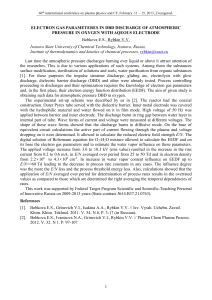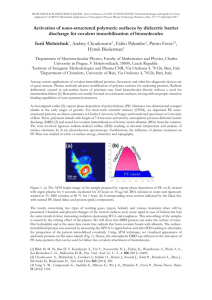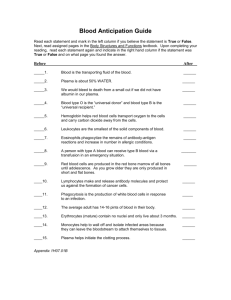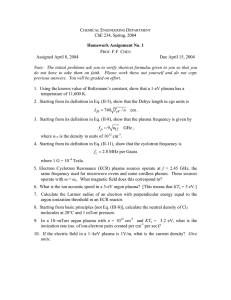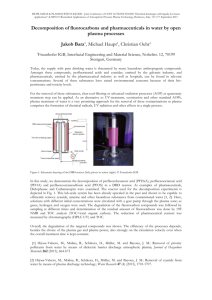A COMPARATIVE STUDY OF HELIUM AND ARGON DBD
advertisement
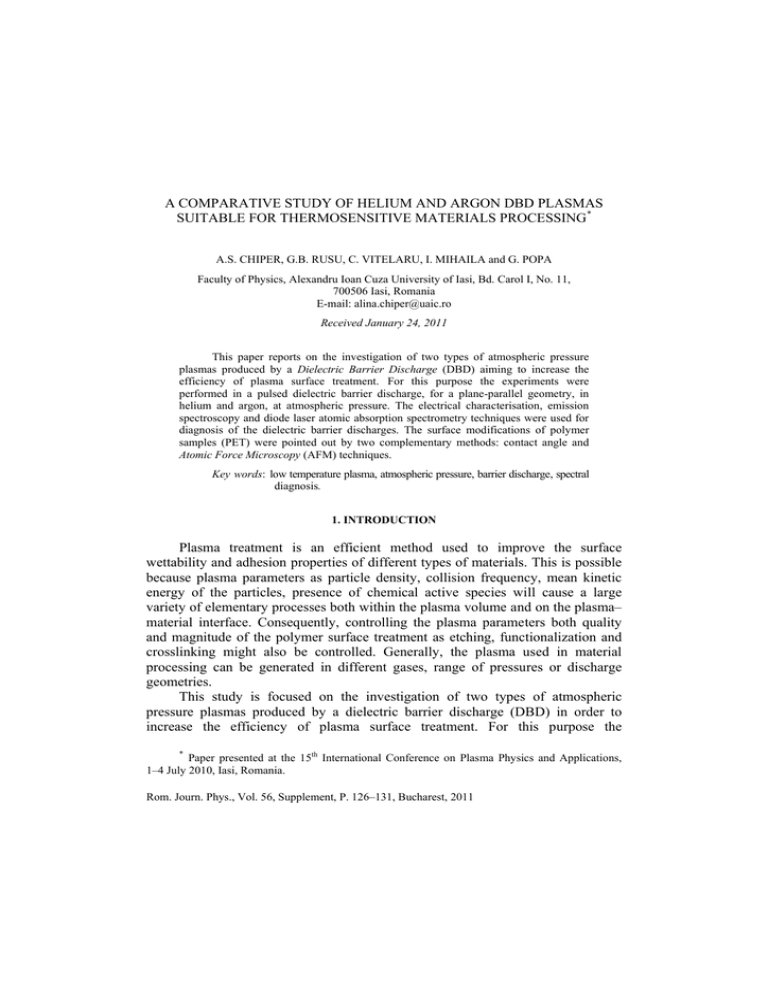
A COMPARATIVE STUDY OF HELIUM AND ARGON DBD PLASMAS SUITABLE FOR THERMOSENSITIVE MATERIALS PROCESSING* A.S. CHIPER, G.B. RUSU, C. VITELARU, I. MIHAILA and G. POPA Faculty of Physics, Alexandru Ioan Cuza University of Iasi, Bd. Carol I, No. 11, 700506 Iasi, Romania E-mail: alina.chiper@uaic.ro Received January 24, 2011 This paper reports on the investigation of two types of atmospheric pressure plasmas produced by a Dielectric Barrier Discharge (DBD) aiming to increase the efficiency of plasma surface treatment. For this purpose the experiments were performed in a pulsed dielectric barrier discharge, for a plane-parallel geometry, in helium and argon, at atmospheric pressure. The electrical characterisation, emission spectroscopy and diode laser atomic absorption spectrometry techniques were used for diagnosis of the dielectric barrier discharges. The surface modifications of polymer samples (PET) were pointed out by two complementary methods: contact angle and Atomic Force Microscopy (AFM) techniques. Key words: low temperature plasma, atmospheric pressure, barrier discharge, spectral diagnosis. 1. INTRODUCTION Plasma treatment is an efficient method used to improve the surface wettability and adhesion properties of different types of materials. This is possible because plasma parameters as particle density, collision frequency, mean kinetic energy of the particles, presence of chemical active species will cause a large variety of elementary processes both within the plasma volume and on the plasma– material interface. Consequently, controlling the plasma parameters both quality and magnitude of the polymer surface treatment as etching, functionalization and crosslinking might also be controlled. Generally, the plasma used in material processing can be generated in different gases, range of pressures or discharge geometries. This study is focused on the investigation of two types of atmospheric pressure plasmas produced by a dielectric barrier discharge (DBD) in order to increase the efficiency of plasma surface treatment. For this purpose the * Paper presented at the 15th International Conference on Plasma Physics and Applications, 1–4 July 2010, Iasi, Romania. Rom. Journ. Phys., Vol. 56, Supplement, P. 126–131, Bucharest, 2011 2 A comparative study of Helium and Argon DBD plasmas suitable 127 experiments were performed in a pulsed dielectric barrier discharge, for a planeparallel geometry, in helium and argon. Helium and argon have been choose as being the most convenient gases in DBD working at atmospheric pressure due to the fact that they allow stabilizing homogeneous discharges much easier compared with reactive gases, at lower sustaining voltages and thicker discharge gaps. On the other hand, the reactive species are more efficient for plasma treatment and in the case of atmospheric pressure plasmas the reactive species are present either from the residual gas in the chamber or as gas impurities. 2. EXPERIMENTAL SET-UP The experimental setup consists of a plane-parallel geometry of a dielectric barrier discharge (DBD) system excited by positive voltage pulses. The electrical characterisation, the emission spectroscopy and the diode laser atomic absorption spectrometry techniques were used for diagnosis of the dielectric barrier discharges. The applied voltage on the electrodes and the total current through the reactor were monitories using a 350 MHz digital oscilloscope (LeCroy WaveSurfer 434). The emission light of DBD plasma was analyzed using high resolution Triax 550 (Horiba Jobin Yvon) spectrometer. The DL100 (TOPTICA) tunable diode laser absorption spectrometry (TDLAS) system was used to investigate both spatial and temporal evolution of metastable oxygen atoms. The surface modifications of polyethylene terephthalate (PET) were pointed out by two complementary methods: contact angle and Atomic Force Microscopy (AFM) techniques. AFM images were made in tapping mode with 0.1 nm resolution in z direction. Detailed characterization of the experimental set-up and methods used are presented in [1, 2]. The experiments were made at room temperature, in laminar flowing of the spectral helium or argon (Linde Gas) without preliminary vacuum pumping. 3. RESULTS AND DISCUSSIONS For both types of pulse plasmas investigated the applied voltage was varied in the range 1.5–3.5 kV, while keeping constant the frequency (2 kHz) and the working gas flow rate (3000 sccm). The discharge current waveforms presented in Figure 1 shows that the discharge consists of two current peaks, with different polarities, corresponding to each positive voltage pulse. After each current pulse the gas voltage changes drastically [3]. This significant drop of the gas voltage is attributed to a glow mode [4]. Under our experimental conditions, the helium DBD plasma works in glow mode which is characterised by an uniform distribution of plasma parameters in any direction parallel to the electrodes, while each pulse discharge has a single peak current (Figure 1 (a)). On the other hand, the argon DBD plasma works in glow like mode [5], fact indicated by the presence of a single peak current 128 A.S. Chiper et al. 3 corresponding to each pulse discharge, but stil thin microchannels are produced perpendicular to the electrodes superposed on the uniform light distributed along the electrodes. Temporal evolution of the absorption intensity which is characteristic of the oxygen metastable atoms is presented in Figure 1. Experimental results show that the maximum of absorption intensity is delayed by few microseconds after the current peak, namely 1-2 µs in the case of helium DBD plasma (Figure 1 (a)) and about 6-7 µs in the case of argon DBD plasma (Figure 2 (a)). This delay of the oxygen metastables pulse against the current pulse might suggest a mechanism which involves collisions between heavy particle within the balance of the metastables density in the discharge plasma. (a) (b) Fig. 1 – Time evolution of voltage, current and oxygen absorption intensity (777.194 nm) near the HV electrode in: (a) He – DBD and (b) Ar – DBD plasmas. On the other hand, due to the fact that the reactive species are very efficient in plasma treatment, spatial distribution of the reactive species (O, N2, N2+) was investigated. Using the TDLAS technique, as described in detail in [2], it has been proved that the highest density of oxygen metastable atoms is located near the ground electrode (temporary cathode), for helium DBD plasma, while for argon DBD plasma it is placed near the high voltage electrode. Similar results were found by the emission spectroscopy technique for other excited species. Results obtained in He – DBD plasma show that N2+ excited species are predominant near ground electrode, while N2 excited species are almost uniform distributed between electrodes (Figure 2 (a)). Contrary, the argon excited species are distributed predominantly in the vicinity of the high voltage electrode of the DBD system working in argon (Figure 2 (b)). Consequently, in order to increase the efficiency of surface treatment the polymer materials should be placed on the ground electrode when working in helium DBD plasma and on the high voltage electrode when working in argon DBD plasma. 4 A comparative study of Helium and Argon DBD plasmas suitable (a) 129 (b) Fig. 2 Spatial distribution of specific excited species in: (a) He – DBD and (b) Ar – DBD plasmas. Position 0 mm corresponds to ground electrode and position 3 mm corresponds to HV electrode. The surface modifications of polymer samples (PET) were pointed out by two complementary methods: contact angle and Atomic Force Microscopy techniques. The surface treatment was performed in helium DBD plasma or argon DBD plasma for various exposure times up to 120 s. The observed contact angle data show a drastically decrease of the contact angle for treated samples compared with those measured on untreated polymer films. As can be seen in Figure 3, the water contact angle of PET films is found to change from 79° for the untreated sample to the lowest value 39.5° after helium DBD plasma treatment and about 32° after argon DBD plasma treatment. This fact also shows considerable increased hidrophilicity induced by plasma. Moreover, experimental results show that, only for short treatment time, the argon DBD plasma is significantly more efficient than the helium DBD plasma in the modification of PET surface properties, as can be seen in Figure 3. The values of root mean square roughness, Rrms, are calculated from 3 µm × 3 µm AFM images. The pristine samples of PET films are relatively smooth (Rrms=0.9 nm ± 0.1 nm), characterised by a granular topography of relatively small features with no particular spatial arrangement [6]. After helium DBD plasma treatment, roughness of the PET films is not considerably changed; only topographical modifications of polymer treated samples being observed (Figure 4 (a) and (b)). On the other hand, polymer surfaces exposed to argon DBD plasma present an increased roughness. Namely, after argon plasma exposure the localized picks, in the nanoscale range, are preserved and became more pronounced for the samples treated in argon plasma (Figure 4 (c) and (d)) than in helium plasma. 130 A.S. Chiper et al. 5 Fig. 3 – Contact angle of water on PET film versus treatment time measured after treatment in He – DBD plasma or Ar – DBD plasma. (a) Rrms = 0.9 nm ± 0.1 nm (b) Rrms = 1 nm ± 0.1 nm (c) Rrms = 2.5 nm ± 0.1 nm (d) Rrms = 2.7 nm ± 0.1 nm Fig. 4 – Topography AFM images of PET surfaces: (a) 10 s and (b) 120 s treated in He – DBD plasma; (c) 10 s and (d) 120 s treated in Ar – DBD plasma. 6 A comparative study of Helium and Argon DBD plasmas suitable 131 4. CONCLUSION This paper reports on the investigation of two types of atmospheric pressure plasmas produced by a dielectric barrier discharge (DBD) aiming to increase the efficiency of plasma surface treatment. Based on the experimental results obtained by TDLAS technique and emission spectroscopy it has been proven that the highest density of the excited species is located near the ground electrode (temporary cathode) of a helium DBD plasma, while for an argon DBD plasma it is placed near the high voltage electrode. Consequently, to increase the efficiency of DBD system used for surface treatment, it could be advantageous to place the polymer materials on that electrode which has the highest density of the excited species in front of it. Moreover, contact angle data show that Ar – DBD plasma is more efficient for the modification of PET surface properties than the He - DBD plasma. After He - DBD plasma treatment only topographical modifications of polymer treated samples were observed, while polymer surfaces exposed to Ar – DBD plasma present an increased roughness. Acknowledgement. This research work has been supported by the Romanian Ministry of Education and Research under contract PLASMOS no. 72225/2008. REFERENCES 1. A.S. Chiper, V. Aniţa, C. Agheorghiesei, V. Pohoaţă, M. Aniţa, G. Popa, Plasma Process. Polym. 1, 57–62 (2004). 2. A. S. Chiper, R. Cazan, G. Popa, IEEE Transactions on Plasma Science 36, 5, 2824–2830 (2008). 3. A S. Chiper, G. B. Rusu, A. V. Nastuta, G. Popa, IEEE Transactions on Plasma Science 37, 10, 2098–2102 (2009). 4. F. Massines, P. Segur, N. Gherardi, C. Khamphan, A. Ricard, Surf. Coat. Technol. 174/175, 8–14 (2003). 5. Y. B. Golubovskii, V. A. Maiorov, J. Behnke, J. F. Behnke, Plasma Process. Polym. 2, 188–192 (2005). 6. A. S. Chiper, A. V. Nastuta, G. B. Rusu and G. Popa, Nuclear Instruments and Methods in Physics Research B 267, 2, 313–316 (2009).
